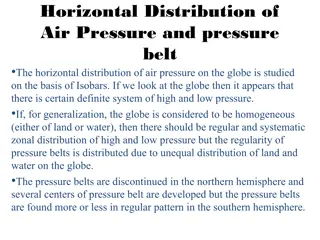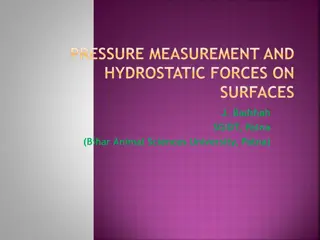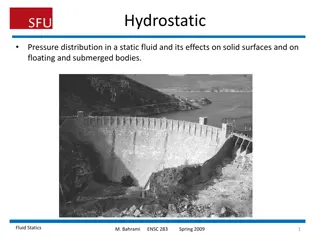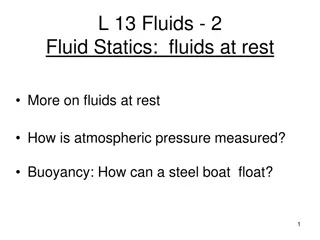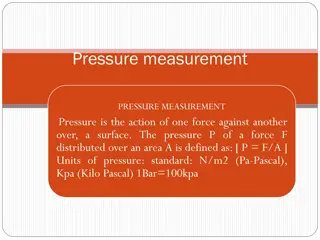Pressure and its Measurement
This informative guide covers pressure basics, measurement techniques, various types of pressure, and pressure measuring equipment like piezometers and manometers. Learn about atmospheric pressure, absolute pressure, gauge pressure, and more.
Download Presentation

Please find below an Image/Link to download the presentation.
The content on the website is provided AS IS for your information and personal use only. It may not be sold, licensed, or shared on other websites without obtaining consent from the author.If you encounter any issues during the download, it is possible that the publisher has removed the file from their server.
You are allowed to download the files provided on this website for personal or commercial use, subject to the condition that they are used lawfully. All files are the property of their respective owners.
The content on the website is provided AS IS for your information and personal use only. It may not be sold, licensed, or shared on other websites without obtaining consent from the author.
E N D
Presentation Transcript
Pressure and its Measurement Created by : Mr. Akil V. Memon (M.E. Civil IWM)
Pressure Fluid has property that it exerts force on all the sides, top and bottom. Pressure exerted by fluid is given as force per unit area which is as follows: The SI unit of pressure is newton per square metre (N/m2). This is also known as pascal (Pa).
Pressure Head In a static liquid , vertical distance from datum line to the free surface of liquid is known as Pressure Head. P= weight of liquid in the cylinder/ Area of the cylinder base = w h A/A (weight= volume density, volume=h A and density =w) =w h If specific gravity of liquid is use then P= w s h We also know that P=wh (w= weight density) P= g h ( = mass density)
Various Types of Pressure Atmospheric Pressure: The air surrounding the earth possess some weight. Due to its weight , the air excert some pressure on the surface of the earth. This pressure is known as atmospheric pressure. It can be measure by barometer. Atmospheric pressure is equal to, 760 mm of mercury column 10.3 m of water column 101.3 kN/m2 101.3 kPa 1 bar at sea level at 15 C
Absolute Pressure: When pressure is measured with reference to absolute zero pressure it is known as absolute pressure. i.e. absolute zero pressure line is taken as datum. Gauge Pressure: When pressure is measured with referece to atmospheric pressure , it is known as gauge pressure (+ve gauge pres.). Bourdon tube pressure gauge measures GP. Vaccum Pressure: When pressure is measured with reference to atmospheric pressure, but it is below atmospheric pressure, it is known as vaccum pressure(-ve gauge pre.). Berometer measures VP.
Pressure Measuring Equipment's: Piezometer Simple U-tube mano. Differential U-tube.. Inverted U-tube.. Manometers PME Bourdon tube Press. gauge Diaphragm gauge Bellows gauge Dead weight gauge Mechanical Gauges
Piezometer A piezometer is the simplest form of the manometer. It measures gauge pressure only. The pressure at any point in the liquid is indicated by the height of the liquid in the above that point, which calibrated scale on glass tube. tube the can read on It consist of a tube, one end of which is connected to pipeline in which pressure is required to be found out. The other end is open atmosphere, in which liquid can rise freely without overflow. The height to weight the liquid rises up in the tube gives pressure head directly. to the The pressure at point A is givenby; ? = ?? = ? Therefore h= p/ ??
Simple U-tube Manometer It is an improved form of a piezometer. It consist of a tube bent in u- shape, one end of which is attached to the gauge point and the other is open to the atmosphere. Heavy liquid like mercury (s= 13.6) is filled in the u- tube. It is also known as manometric fluid. Due to pressure of liquid in the pipeline, mercury is displaced in the u-tube. Displacement of mercury is measured in terms of head h1 and h2. It can be used to measure high pressure and negative pressure.
For Positive pressure ?? ? ?+ ?1 1 ?2 2= 0 ?? ? ?= ?1 1+ ?2 2 h= ?1 1+ ?2 2 For Negative pressure ?? ? ?+ ?1 1+ ?2 2= 0 ?? ? ?= ?1 1 ?2 2 h= ?1 1 ?2 2
Differential U- tube manometer Let the two points A and B are at different level and also contains liquid of different specific gravity. These points are connected to the u-tube differential manometer. Pressure head in the left limb above datum = ?+ ?1 1 Pressure head in the right limb above datum = ?+ ?2 2+ ?. Since pressure head in both the limbs above the datum are equal ?+ ?1 1= ?+ ?2 2+ ?. ?- ?=?2 2+ ?. ?1 1 Heavy liquid like mercury is used to fill in the u tube.
Inverted U-tube Manometer Pressure head in the left limb above datum = ? ?1 1 Pressure head in the right limb above datum = ? ?2 2 ?. Since pressure head in both the limbs above the datum are equal ? ?1 1= ? ?2 2 ?. ?- ?= ?2 2 ?. + ?1 1 Light liquid is used as manometric fluid
BOURDON TUBE PRESSURE GAUGE The components of bourdon gauge are bourdon tube , sector, pinion, dial gauge , pointer The bourdon pressure gauge is suitable for measuring not only high pressures such as those in a steam boiler or a water main but also negative or vaccum pressures. A gauge which is so devised to measure positive as well as negative pressures is called a compound gauge.



